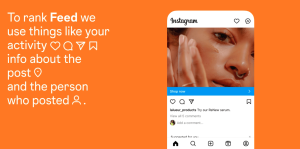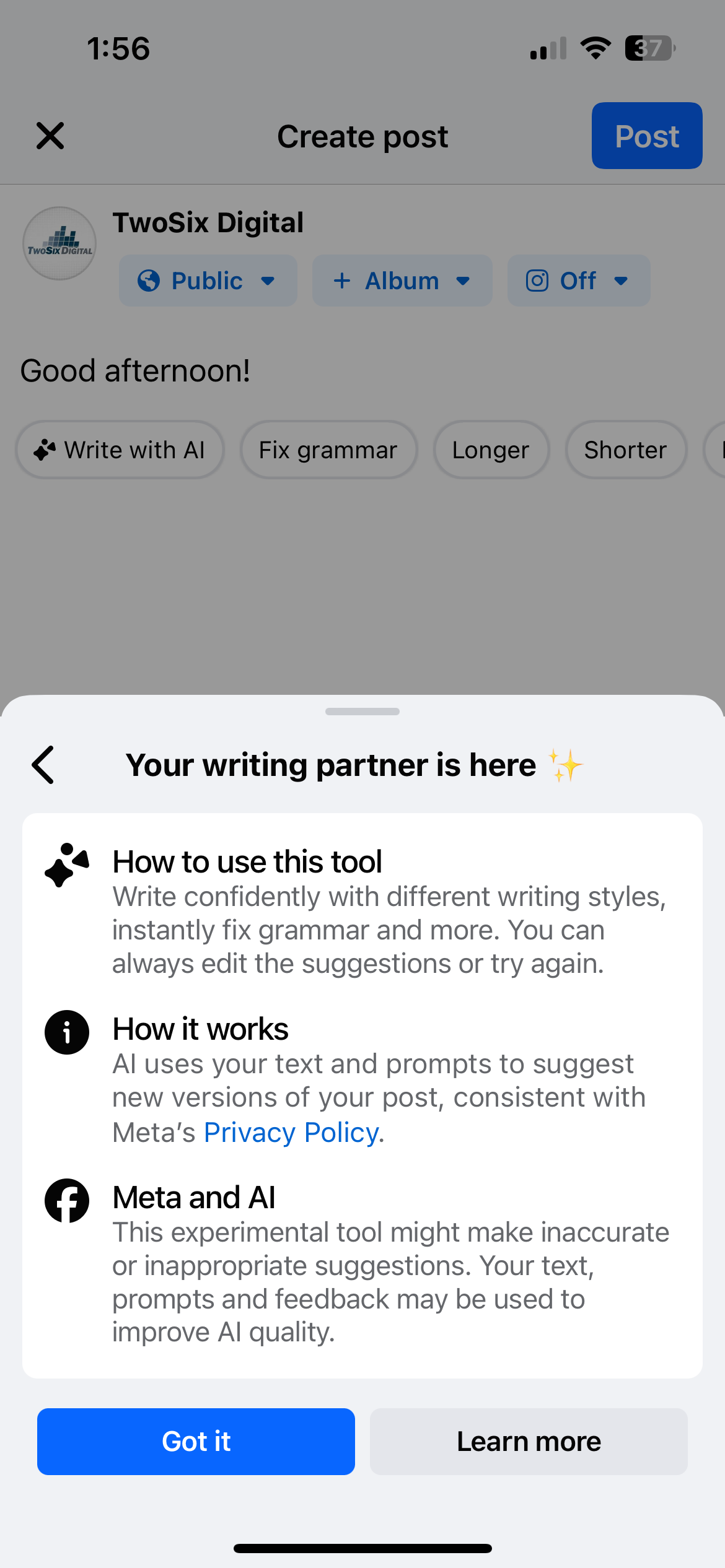The TwoSix team is back and ready to share what’s On Our Radar for March so that you can stay ahead of the always-evolving digital marketing landscape. This month the TwoSix team discusses how adults are using TikTok, how to rank on Instagram, and much more! Keep reading to find out what we’re keeping On Our Radar for March 2024.

According to a recent study by Pew Research Center, a striking statistic reveals that the top 25% of U.S. adults on TikTok, based on posting volume, generate a staggering 98% of all publicly accessible videos on the platform! Despite this dominance, TikTok’s user base among American adults is relatively small, with only 22% reporting using the app.
Furthermore, the study indicates that TikTok’s user demographics skew younger, with 48% of adults aged 18 to 29 claiming to use the platform. And, another study has found that 64% of GenZ are using the app as a search engine.
At the Destinations International Marketing and Communications Summit, held in Salt Lake City in February, DMO attendees noted that TikTok was one of their channels with the least presence – almost 30% less than Facebook and Instagram.

Additionally, while TikTok is widely recognized for its entertaining content, the study suggests that many users also turn to the platform for news and information. This may be the optimal place for your destination or tourism related business to make an impact, especially with a such large audience of GenZ and Millennials.
It is time to build on the 25%!

Typically, we’ve been seeing social media channels copy TikTok’s most popular features. That’s not a case with the latest push from TikTok to push horizontal videos. Not just horizontal videos, but up to 30-minute long horizonal videos! It sure sounds like TikTok is making its push into the long-form game. This provides yet another opportunity for creators to distribute their existing content into new places. What’s the harm in adding a horizontal upload from your YouTube Channel to your TikTok frequency? I can’t personally think of a reason not to at this point especially since TikTok is promising increased video views from the new horizontal format. Also, as far as we know, redundant content from network to network isn’t being penalized at this time like it once was.
This is an interesting development for sure, as YouTube over the last year has strived to become more TikTokish. Now we see TikTok becoming more YouTubey. It just never ends. One thing is for sure, when new formats roll out, you should use them. You’re likely going to be rewarded by the algorithmic gods!
Will you be experimenting with some horizontal videos on TikTok? If so, let us know how they go!

Like any social media platform, Instagram can be a tricky beast to tame — especially since there’s so many different types of posts. We always have people ask: what should I post on Stories? Do I need to post Reels? Why aren’t my Photo posts working? Last year, Instagram posted a blog about how content is ranked on its platform, and recently, its head, Adam Mosseri, gave us some more insights.
The most obvious takeaway from the article was that “each part of the Instagram app uses its own algorithm.” Feed, Stories, Explore, Reels, and Search serve content differently — consequently, you should approach each with a unique approach. Instagram gives examples like, “People tend to look for their closest friends in Stories, use Explore to discover new content and creators and be entertained in Reels.”

In Feed, the five types of interactions that determine if a user is likely to see a post are the number of seconds users spend on a post, comments, likes, shares, and profile photo taps. Mosseri explains that using carousels can improve your reach, because each slide gives the post another opportunity to show up in the Feed. Similarly, putting music on photos is a great idea, as users are more likely to spend time on it.
In terms of Stories, the head of Instagram recommends giving “authentic insights” with behind-the-scenes content. Mosseri goes as far as to basically say, if you can’t do that, it’s fine, don’t bother with Stories. And he says that about every type of content. Essentially, your content should always be an overlap between your goals and what your followers want to see.

AI is more accessible than ever and advertises in every sector and industry have begun using these tools to create promotional graphics quickly and at low cost. At TwoSix, we use Photoshop’s AI to improve image sizing or make small fixes – things that used to take a lot more time. Online language learning models like Chat GPT and Google’s Gemini are great for generating ideas for new ways to promote content. However, some organizations have started creating entire promotional graphics just using AI, without any human oversite or execution.
The most recent example of this to make headlines is the Willy’s Chocolate Experience. The $45 USD ticketed event promised to be a “chocolate fantasy like never before” and “a place where chocolate dreams become a reality” turned out to be a few decorations spread out in a nearly empty warehouse, with actors reading nonsensical AI-generate scripts. This causes a huge amount of backlash at the Glasgow event, ultimately leading to event cancelation mid-way through the first day.
The signs that the event was not what it seemed where on the website if one looked carefully, with text on some of the graphics being so poorly generated that they weren’t even English (“enchernign” rather than “enchanting, or “Cartchy Tuns” instead of “catchy tunes”).
This entire debacle is a great reminder that AI is not at the level of people yet. Event promotion and advertising creative still clearly needs a personal touch to accurately reflect reality. With many CVBs and other tourism organizations using AI to help write blog posts and ad copy, it’s more important than ever to ensure that what we’re putting out there matches up to the experience that people will find when they visit.

There are a plethora of marketing trends taking off in 2024. From investing in influencers to being unique and authentic, there are simple ways to make your business or destination stand out.
Over the last few years, we’ve seen a rise in people interested in brands who seem authentic and honest. That trend is continuing as 71% of Americans relate to authentic brands and are more willing to support them. What does this mean for you? When creating content be real. Super polished content is quickly being replaced by real life content and it’s working, users are responding better and engaging more. This means you can take your phone and create a quick 30 second clip of something interesting or unique in your destination and post across your platforms for a real first-hand look that users will appreciate and engage with. Using a local creator is a great option as well, someone who has a following in your destination can bring a whole new audience to your channel or site and can potentially spark more interest. The bottom line, keep it simple and short, share your destination from an authentic perspective and people will respond.

There’s no doubt that generative AI has made a huge impact on the digital marketing space. AI tools have been a huge help for marketers with everything from creating engaging copy to efficiently editing images. In recent months, generative AI tools have started to make their way to social media and I am not convinced this is helpful to the social app experience.
If you’re not familiar with these new social media generative AI tools, here’s a list of the updates as of late February from SocialMediaToday:
 Facebook has an AI post creation tool, generative AI text and image creation for ads, AI chatbots based on celebrities, and AI assistant in Messenger, generative AI stickers, an AI chatbot assistant in Ray Ban Stories, and generative AI profile pictures.
Facebook has an AI post creation tool, generative AI text and image creation for ads, AI chatbots based on celebrities, and AI assistant in Messenger, generative AI stickers, an AI chatbot assistant in Ray Ban Stories, and generative AI profile pictures.- Instagram has generative AI image filters and background generation tools, and AI creation and editing options, while it’s also experimenting with a conversational AI chatbot for DMs.
- LinkedIn has an AI post composer, an AI assistant for InMails, AI article summaries, generative AI tools that can write your profile for you, and job ads suggestions, among other tools within its Recruiter and ad options.
- Snapchat has its “My AI” conversational chatbot, as well as its “Dreams” image generation tool,, along with AI-generated Snap captions (for paying subscribers), and “AI Mode” for creating generative AI Snaps.
- TikTok has AI profile images, AI effects tools, and AI song generation, while it’s also experimenting with conversational search, powered by AI, text-to-video generation, as well as an integrated chatbot experience.
- Pinterest is primarily using generative AI, at this stage, to power its back-end search and ad tools.
- X owner Elon Musk says that X’s “Grok” AI chatbot will soon be able to create in-app updates for you, while they’re also exploring visual generation via the tool.
As you can see, these tools are mostly aiming to mirror human updates and responses. Unfortunately, the effects of generative AI will ultimately be less human input and more “robot” responses. The question is- do your average social media users even want that? Although some creators or brands may find these tools useful for responding to comments or creating posts promptly, your average Facebook user probably doesn’t want to read similar-sounding updates from their friends, family, and favorite organizations all day long.
Spam has always been a massive problem for social media platforms as it is equally as annoying as it is dangerous. Security becomes an even larger concern when you can no longer differentiate human posts from robots. So, why would anyone want this and who are these social media apps trying to appeal to? At the end of the day, social media is supposed to be social interactions between humans and bot updates likely aren’t going to help with that.
As we continue to navigate generative AI in social media apps, I would suggest leaning into your humanity and realness as much as possible. Humanizing your destination is going to be a game changer when your competition is utilizing robot copy. Continue to make use of user-generated content, showing the faces behind your organization, including video content with voiceovers, and experimenting with new ways to be authentic on social media. At the end of the day, human interaction will never go out of style, but AI writing is destined to.
With the ever-changing digital marketing world, we are here to keep you informed of new digital trends and what we are keeping on our radar for March 2024. Have any questions? Contact us! We’re here to help.
Make sure to subscribe to our newsletter to stay in the loop on all things TwoSix Digital.


 Facebook has an
Facebook has an 




